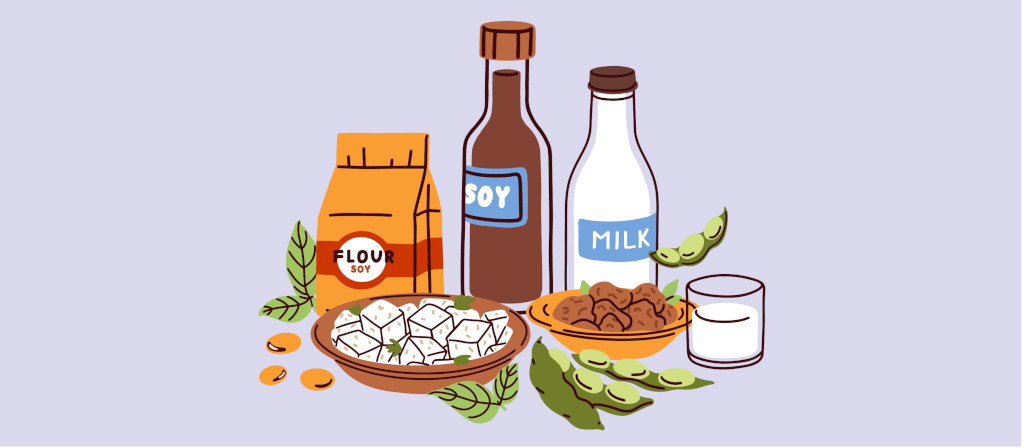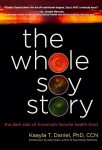The Dark Side of Soy
A groundbreaking exposé that tells the truth about soy that scientists know but the soy industry has tried to suppress

Key findings of the article:
- Soy is not a healthy food, does not prevent diseases, and is not even proven safe
- Health ministries are already warning against soy products, especially for babies and children
- Asians traditionally eat only small amounts of fermented soy products as condiments
- Modern industrial soy processing creates toxic and carcinogenic residues
Over the past two decades, soy has been widely promoted as a ‘miracle’ food that can prevent heart disease, fight cancer, fan away hot flushes and build strong bones and bodies in a myriad of ways. Sales of soy foods topped $4 billion in the USA for the first time in 2004, with most segments of the industry reporting double-digit growth.
The marketing of soy as a ‘health food’ has been so successful that few people realize that respected scientists have warned that possible benefits should be weighed against proven risks. Even researchers working for the soy industry have admitted to each other at soy symposia that the ‘marketing is way ahead of the science’.
Official Warnings Are Mounting
Fortunately, the ‘whole soy story’ is starting to emerge. In July 2005, the first major alert came from the Israeli Health Ministry, which warned that babies should not receive soy formula, that children under 18 should eat soy foods no more than once a day to a maximum of three times a week and that adults should exercise caution because of adverse effects on fertility and increased breast cancer risk.
International warnings:
- Israel (2005): No soy baby formula, restrictions for children
- Cornell University: Warns of increased breast cancer risk
- French Government: Removing soy isoflavones from infant formula
- Germany (2007): Warning against soy infant formula without medical indication
- United Kingdom: Committee on Toxicity finds no merit in health claims
The Ministry’s advice came from a 13-member committee of nutritionists, oncologists, pediatricians and other experts who examined the evidence for a year. The committee was most concerned by the possibility of hormonal disruption caused by the estrogen-like plant hormones in soy.
The Asian Myth Debunked
For consumers, such news can be confusing. After all, ‘everyone knows’ that Asians eat large quantities of soy and consequently remain free of most western diseases. In fact, the people of China, Japan and other countries in Asia eat small quantities of soy and as condiments, not as staple foods.
While it is true that Asians show lower rates of breast, prostate and colon cancers, they suffer higher rates of thyroid, pancreatic, liver, stomach and esophageal cancers. Thyroid disease is also prevalent in Asia, with an epidemic of cretinism in some parts of China, and with ‘Hashimoto’s thyroiditis’ and other thyroid problems common in Japan.
Asians also eat different soy foods from the ones now appearing on western tables, especially regarding fermented vs unfermented soy. Think small amounts of traditional, whole soy foods such as miso, natto, tempeh, tofu, tamari and shoyu, not veggie burgers, ‘energy bars’, shakes, TVP chili, soy milk or other meat or dairy substitutes.
Contrary to popular belief, soy milk was rarely drunk in Asia prior to the 20th century and soy formula was first invented by a Baltimore pediatrician in 1909.
Dangerous Industrial Processing
Ingredients such as soy protein isolate, soy protein concentrate, textured soy protein and hydrolyzed plant protein were unheard of until after World War II. These quintessentially western products are manufactured using high-tech, industrialized processes that compromise protein quality, reduce vitamin levels and leave toxic residues and carcinogens.
Although the latest refining techniques yield blander, purer soy proteins than the ‘beany’, hard-to-disguise flavors of the past, the main reason the new soy foods taste and look better is the lavish use of sugar and other sweeteners, salt, artificial flavorings, colors and monosodium glutamate.
GM Soybeans and Rising Allergies
Soy is now an ingredient in more than 60 percent of the foods sold in supermarkets and natural food stores, with much of it ‘hidden’ in products where it would not ordinarily be expected, such as in fast-food burgers, breads and canned tuna.
This is becoming a nightmare for the growing number of people who are allergic to, or sensitive to, soy – which is a lot of people, given that soy is now one of the top eight allergens, with many experts predicting it will soon be in the top four.
GM Soy and Allergies: The York Nutritional Laboratories in England found a 50 percent increase in soy allergies in 1998, the same year in which GM beans were introduced to the world market. One of the 16 proteins in soybeans most likely to cause allergic reactions was found in concentrations 30 percent or higher in Monsanto’s GM soybeans.
Natural Anti-nutrients and Toxins
Unfortunately, the health problems caused by soy are not completely solved by eating whole bean products and buying organic. All soybeans naturally contain anti-nutrients, toxins and plant hormones:
Major anti-nutrients in soy:
- Protease inhibitors: Interfere with protein digestion, cause malnutrition, poor growth, digestive distress and pancreatitis
- Phytates: Block mineral absorption, causing zinc, iron and calcium deficiencies
- Lectins and saponins: Linked to ‘leaky gut’ and other gastrointestinal and immune problems
- Oxalates: Can promote kidney stones and vulvodynia
- Oligosaccharides: Cause gas, giving soy its reputation as the ‘King of Musical Fruits’
Apologists for soy dismiss such claims, saying that food processing and home cooking remove most of these anti-nutrients. In fact, modern processing removes some of them, sometimes a lot of them, but never all.
The Riskiest: Phytoestrogens
Riskiest of all are the high levels of phytoestrogens (plant estrogens) in soybeans. Although these are said to be ‘weak estrogens’ and are promoted as ‘safe and natural’ hormone replacement therapy, they are strong enough in numbers to cause significant endocrine disruption, leading most often to hypothyroidism, with its symptoms of weight gain, fatigue, brain fog and depression.
More than 70 years of human, animal and laboratory studies show that soybeans put the thyroid at risk. Although individuals deficient in iodine are especially prone to soy-induced thyroid damage, this can also occur even when iodine levels are replete.
Soy phytoestrogens also have a ‘contraceptive effect’. Fertility problems in cows, sheep, rabbits, cheetahs, guinea pigs, birds and mice have been regularly reported since the 1940s.
In women, soy can impair the ovarian development of babies, alter menstrual cycles and cause hormonal changes indicative of infertility for adults. In men it lowers testosterone levels, the quantity and quality of sperm and the libido.
Infants at Highest Risk
Humans and animals appear to be the most vulnerable to the effects of soy estrogens pre-natally, during infancy and puberty, during pregnancy and lactation, and during the hormonal shifts of menopause. Of all these groups, infants on soy formula are at the highest risk.
Soy formula risks:
- Premature puberty in girls
- Delayed or arrested puberty in boys
- Thyroid damage and other disorders
- 50 to 80 times the amount of manganese found in dairy formula – toxic levels that can harm the developing brain
- Links to ADD/ADHD and other learning and behavioral disorders
Soy formula now represents about 25 percent of the bottle-fed market. These and other known hazards of soy formula have led the Israeli Health Ministry, the Swiss Federal Health Service, the British Dietetic Association and others to warn parents and pediatricians that soy infant formula should never be used except as a last resort.
Questionable Cancer Claims
Despite these and many other potential dangers, soy is still widely promoted as a health food – even as a ‘miracle food’ that can prevent and cure cancer. While a few studies suggest that soy protein – or its phytoestrogens – might help prevent cancer, far more show it to be ineffective or inconsistent.
Some studies even show that soy can contribute to, promote or even cause cancer. In 2004 the Solae Company petitioned the FDA to allow a cancer health claim for soy protein. In fact, no such consensus existed then or now and numerous experts warned of soy protein’s carcinogenic potential.
In 2004/5 the Weston A Price Foundation and the author submitted three detailed documents to the FDA that refuted Solae’s claims that soy prevents cancer. In October 2005, Solae withdrew its petition.
Recently, the marketing of soy for cancer prevention hit a big setback with a study showing that soy isoflavones do not worsen primary tumors but do cause metastases, a sobering finding for all who would make health claims for soy.
Fermented vs. Unfermented
The ancient Chinese and Japanese knew soybeans must be soaked, cooked and fermented in order to transform them into an edible and healthful food. When we ferment food, we enlist bacteria, fungi and other beneficial microorganisms to help break down complex proteins, starches and fats into highly digestible amino acids, simple sugars and fatty acids.
Traditional vs. modern soy products:
- Traditional fermented: Miso, natto, tempeh, tamari, shoyu
- Traditional precipitated: Tofu (in small quantities as condiment)
- Modern industrial: Soy protein isolate, textured vegetable protein, soy milk, veggie burgers
Surprisingly, soy milk is not a traditional product. The first historical reference to it as a beverage appears in 1866 and it was not popularized until the 1920s and ’30s when American Seventh Day Adventist missionaries developed soy milk processing plants.
The Bottom Line
The safety of soy foods and formula has yet to be proven and people eating large quantities of soy – often unknowingly – are unwittingly participating in a large, uncontrolled and unmonitored, human experiment.
The greatest health hazards come from industrially processed, soy protein ingredients, such as soy protein isolate, textured vegetable protein, hydrolyzed soy protein and other ingredients that were developed after World War II.
Their manufacture involves high temperatures, intense pressure, hexane and other solvents, alkaline and acid baths and other processing methods that deplete nutritional value and leave toxic residues, such as carcinogenic nitrosamines.
This article is based on the original contribution by Dr. Kaayla T. Daniel and summarizes the key findings from her book “The Whole Soy Story”. It serves to educate about the risks of soy products and does not replace individual nutritional counseling.
 Original source: Dr. Kaayla T. Daniel – “The Dark Side of Soy”, from the book “The Whole Soy Story: The Dark Side of America’s Favorite Health Food”
Original source: Dr. Kaayla T. Daniel – “The Dark Side of Soy”, from the book “The Whole Soy Story: The Dark Side of America’s Favorite Health Food”